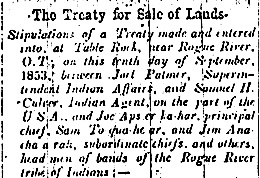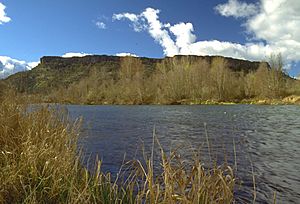Table Rock Indian Reservation facts for kids
The Table Rock Reservation was a special area of land set aside for Native American people in Oregon, United States. It was created in 1853 through a treaty with the Rogue River Indians. This reservation didn't last long. After the Rogue River Wars ended in 1856, the Native American families living there were moved to different reservations. It was located in Southern Oregon, near Upper Table Rock and Evans Creek.
Contents
A Brief History of Table Rock Reservation
Early Conflicts and Treaties
In the early 1850s, people discovered gold in Oregon. This led to problems between gold miners and the Rogue River Indians. These problems grew into serious fighting. To try and stop the fighting, several agreements called treaties were signed. Through these treaties, the Native Americans gave up much of their land.
They first moved to the Table Rock Reservation. Later, they were moved again to the Grand Ronde Reservation and the Coast Reservation. A small part of the Coast Reservation is now known as the Siletz Reservation.
Life on the Reservation
The Native Americans traded most of the Bear Creek Valley for the Table Rock Reservation. Life on the reservation was very hard. In October 1855, there wasn't enough food, and the winter was very cold. Many families became sick.
Because of these tough conditions, a group of Takelma Indians decided to return to their old village. This village was at the mouth of Little Butte Creek on the upper Rogue River.
The Battle of Hungry Hill
After the Takelma Indians returned to their old village, a group of volunteer soldiers attacked them. Tragically, 23 people, including women and children, lost their lives. A small group of Native Americans escaped to the Rogue River Canyon. They fought back against miners and settlers from Evans Creek to Galice Creek.
The volunteer soldiers and regular army troops followed them. They caught up in the Grave Creek Hills. The Native Americans fought bravely and caused many losses for the poorly trained troops. This battle became known as the Battle of Hungry Hill. It was a big victory for the Native Americans.
In November, the soldiers attacked again. They tried to surprise the Native Americans. However, the Native Americans heard them cutting trees to build rafts and were ready. The soldiers were defeated once more.
Final Battles and Relocation
More battles took place after this. In the spring of 1856, nearly 200 volunteer soldiers arrived at Ditch Creek on the Rogue River. They fired on the Native American settlement across the river. Up to 30 Native Americans lost their lives during this day-long attack. The survivors were forced to surrender.
In the summer and following winter, licensed hunters captured or killed Native Americans who remained in the area.
In the winter of 1856–57, about 400 Native Americans were marched 200 miles (320 km) north. They walked from Table Rock to the new Grand Ronde Reservation in Yamhill County. The survivors of the Battle of Hungry Hill took a different path. They boarded a steamboat at Port Orford, Oregon. They traveled by the Columbia River and Willamette River, then went overland to the Siletz Reservation near the Oregon Coast.



